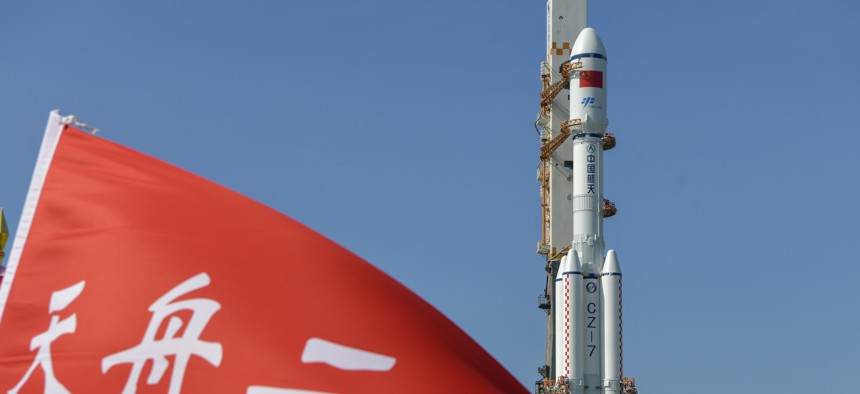
The combination of the Tianzhou-2 cargo spacecraft and the Long March-7 Y3 carrier rocket moves to the launching area of the Wenchang Spacecraft Launch Site on May 16, 2021. Photo by Luo Yunfei/China News Service via Getty Images
Keep Tabs on China’s Growing Space Situational Awareness
As more Chinese satellites reach orbit, Beijing is upgrading its ability to track space debris. But such sensors can be used to destroy as well as protect.
No one was hurt when a Chinese Long March 5B rocket crashed into the Indian Ocean on May 9, but the uncertainty that surrounded the impact highlights the need to better track space junk — and its effects on U.S.-China security dynamics. As humanity has begun to reach orbit with an almost mundane regularity, near space is increasingly crisscrossed by thousands of unguided objects — defunct satellites and cast-off components — traveling at unearthly speeds. This has been exacerbated by a number of events, including a 2007 Chinese antisatellite missile test that created more than 3,000 pieces of debris, the 2009 collision of a Russian military communications satellite with an Iridium commercial communications satellite, and a 2019 ASAT test by India.
Keeping close tabs on orbiting objects — satellites as well as space debris — requires sophisticated infrastructure: radars, optical telescopes, lasers, and, increasingly, space-based sensors. And as the Institute for Defense Analysis has observed, “Until recently, the United States Department of Defense (DoD) was the only organization in the world—outside, perhaps, of Russia—to develop high-fidelity space situational awareness (SSA) information.” But this is clearly changing. A variety of open evidence shows that China is making significant investments in SSA to support both its civilian and military space programs.
China has high ambitions for space. It plans to become a “space great power” by 2030 atop a set of space “megaprojects” currently underway. Chinese state planners see the space launch and satellite services industry as an economic bonanza, and have tied these services into other state plans like the Belt and Road Initiative as the Belt and Road Space Information Corridor. Many of these are explicitly dual-use: redundant constellations of communications, navigation, datalinks and remote sensing satellites to help drive China’s economic growth while supporting military operations.
But the more satellites China puts into orbit, the more it needs to keep track of objects that might threaten them. An article from 2015 described Chinese satellites and spacecraft (129 at the time) as experiencing an average of 30 close encounters (within 100 meters) with space debris each year. Adequately anticipating these conjunctions in time to make adjustments to orbits requires current data on satellites and debris.
A less covered but important story is the growth and increasing sophistication of China’s ground-based infrastructure to support space operations — including developing its own SSA capability. In 2015, the Chinese Academy of Sciences’ National Astronomical Observatories of China and the China National Space Administration established the Space Debris Monitoring and Application Center [空间碎片监测与应用中心] to help coordinate space monitoring systems. In 2018, officials announced that they would build a space debris monitoring base [空间碎片监测基地], complete with large-aperture space telescopes, infrared optical sensors, and radars, in in western China’ Xinjiang province. Currently, the People’s Liberation Army relies on an extensive network of ground stations to downlink data gathered from reconnaissance, weather, and early-warning satellites and determine unit locations through the Beidou global navigation satellite system. This supporting infrastructure is largely operated by the PLA Strategic Support Force, which was established in late 2015 and consolidated many of the various organizations responsible for tracking, testing and launching space vehicles under its Space Systems Department [航天系统部]. Maintaining communication with more than 200 satellites and downlinking their data for commercial and military purposes, including a nascent space-based early warning system and a communications network, will increasingly be vital for China’s modernizing force.
Incidents such as the LM-5B reentry have prompted proposals to better share SSA data with China. But the realm of potential cooperation is limited by the fact that new SSA capabilities, while sometimes affiliated with civilian scientific institutes, regularly have their missions couched in terms of military-civil fusion. They also support Chinese military space operations, which include not only normal operation of military space systems, but also the characterization and tracking of enemy satellites in a conflict.
And while SSA can help keep satellites safe, it can also help target them for disabling or destruction. As noted in the public summary of the 2020 U.S. Space Strategy, China has “weaponized space as a means to reduce U.S. and allied military effectiveness and challenge our freedom of operation in space.” This includes development of ground-based laser dazzling systems, jamming systems, and direct-ascent anti-satellite missiles. Despite global condemnation of the 2007 ASAT test, this program appears to be continuing. According to Rod Lee, Director of Research at the China Aerospace Studies Institute, analysis of Chinese media reports suggest that a claimed Chinese “midcourse missile interception test” in February was, in fact, another ASAT test. Some of the indicators include the overlap in how the PLA views kinetic ASAT, which it calls a “space control” mission, and mid-course BMD, which it calls “space defense;” there are also the various media and academic reports revealing that the claimed BMD test involved members of the Strategic Support Force and its control over 63620 Unit.
The vital role that space based systems play in modern economic development and warfighting, and their centrality to China’s strategic plans, makes greater investment in SSA unsurprising. They also illustrate how China is building far more effective capabilities as it pursues great power status in space.
The China Intelligence is an occasional series by P.W. Singer at New America, a think tank based in Washington, D.C.; and Bluepath Labs, a strategic analysis and technology consulting firm that regularly publishes analysis of China based on open sources.
NEXT STORY: Three Political Crises Drove the Gaza Violence



